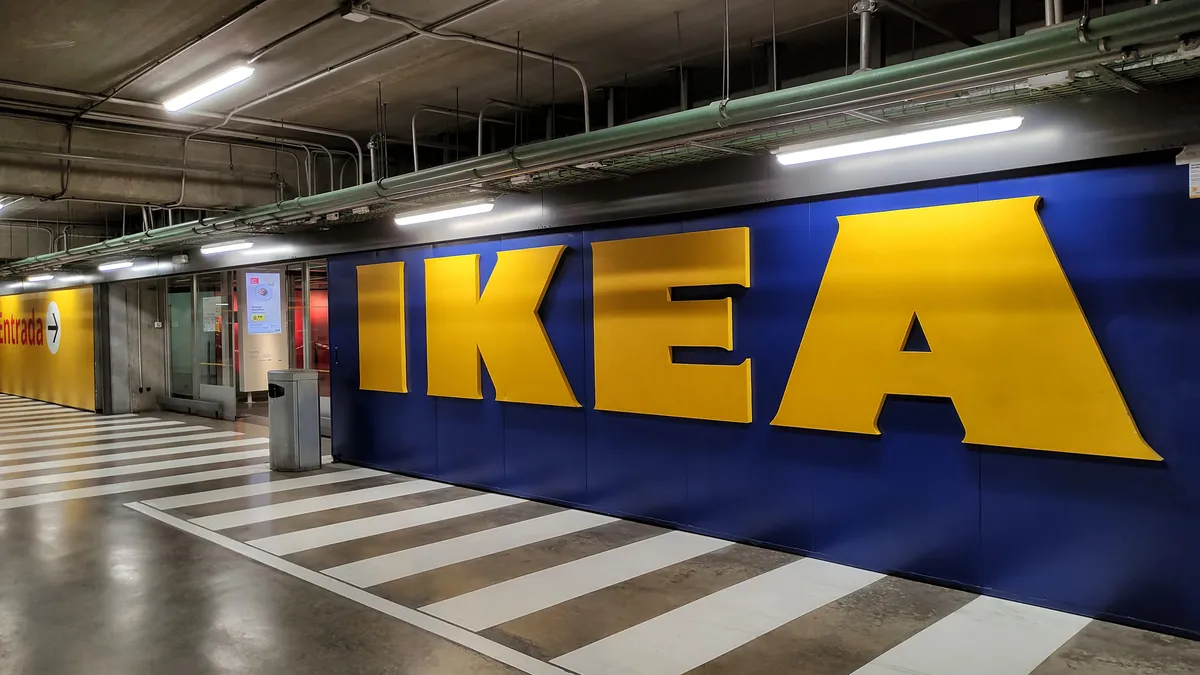The following article is part of the "30 minutes" series, where Retail Dive talks to top executives about some of retail's hottest topics. For more, check out our landing page.

Monica ArnaudoSVP of Merchandising at Ulta
Tenure
2017-Present
Experience
Arnaudo previously held positions as Senior Vice President of Sales at Clarisonic and Senior Vice President of U.S. Sales at Bare Escentuals, along with positions at Sephora and L'Oreal.
Experiential retailers are on the upswing, while department stores sit languishing in the background. It's a familiar narrative. So, too, is the story of Ulta Beauty — a retailer that's making big gains in a space that is both rife with competition and extremely popular.
Ulta made the Fortune 500 list for the first time this year, CEO Mary Dillon was named on Fortune's Most Powerful Women list and the retailer is also posting incredible growth (for example, online sales growth of 60% in the most recent quarter). It's not just e-commerce that's strong at Ulta, though — the retailer has big plans for brick-and-mortar growth as well, and according to Monica Arnaudo, senior vice president of merchandising at the company, that's not changing anytime soon.
"That's the nature of beauty," Arnaudo told Retail Dive in an interview, discussing the success of the company's in-store services, "and why brick and mortar will continue to be strong. Our guests, both male and female, like to come in and experience the products and try them on."
The beauty space is already chock full of competition, and it takes more than just a compelling physical location to lure shoppers in. For Ulta, that means bringing a prestige-level experience to the mass side of beauty, keeping a pulse on consumer trends and differentiating however they can.
A blush of a different color
Despite the rosy glow currently emanating from the beauty sector, Sephora is still the talk of the category, while Ulta tends to occupy a position more in line with Khloe Kardashian: not quite the main event.
That could be changing, though. Ulta Beauty made it onto the Fortune 500 list this year for the first time in the company's history (at number 471), joining Coty (which also made the list for the first time, at number 371), and staying a step ahead of Sally Beauty (611). Ulta's ranking was based on revenues of $5.88 billion, made possible by Ulta's consistent performance this year, both in stores and online.
"It's not just a bunch of pegged merchandise."

Monica Arnaudo
Senior Vice President of Merchandising at Ulta
There might be a lot of options for shoppers to buy mascara nowadays, but when it comes to staying competitive, Ulta has a plan and it consists of one main thing: having a large assortment of mass and prestige products that cater to just about every beauty customer imaginable. That includes keeping abreast of new products and trends in the beauty space, and adding those to the store's product lineup so customers always receive fresh incentives to come shop, Arnaudo notes.
"A lot of times we'll start a brand on dot.com or maybe dot.com and 50-100 stores just because it's a good way to gauge what's working and what isn't working before we roll out to the full fleet of stores," Arnaudo said. "We'll look at sales, we can look at ratings and reviews — we learn pretty quickly the success of a brand."
That method of test introductions has worked well in the past and has led popular beauty brands like ColourPop — which was first introduced in February at just 265 stores — to join the ranks at Ulta. The focus on unique brands, in turn, helps the retailer compete against more prestige-oriented retailers like Sephora.
The focus at Ulta, however, has shifted more to the mass side of the beauty sector, in which Arnaudo hopes to create a similar experience to that which prestige shoppers receive. Traditionally, the beauty experience was separated into two models: the department store model, which organized products by brand and displayed them prominently at their own counters, and the drug store model, which consisted mainly of packaged products on shelves.
Arnaudo's aim is to "elevate" the latter experience so that mass shoppers don't have to settle for an experience that doesn't match up to the prestige level. "It's not just a bunch of pegged merchandise," Arnaudo says of Ulta's mass sections. "We've added navigation. We have more shelving than... pegs. We've added images and graphics, and then, of course, testers, so our guests can feel and touch the products."
While merchandising has been a big focus for Ulta, the hair salon, skin and brow services are also part of the retailer's efforts to stand out from the crowd. The in-store hair salons, which are full service, have been there since the company's founding 28 years ago, while skin and brow services were added in 2008.
"There's a lot of buzz about how brick and mortar has to bring in the experience aspect for their customers," Arnaudo said, "and the beautiful thing for us, is that it's always been a part of our DNA."
Mass growth
Going beyond the rhetoric and walking the walk can be tough, especially in an unforgiving environment in which retailers are filing for bankruptcy left and right. While department stores have their own host of problems, specialty retailers like Ulta have also been singled out as a potentially challenged category with the rise of online marketplaces like Amazon, which thrive off replenishment shoppers.
Ulta's numbers tell a different story. The retailer has opened over 100 stores every year since 2013, and closed less than five annually — numbers that stand in stark contrast to the likes of Macy's and J.C. Penney. According to Arnaudo, the retailer's successful expansion is based, at least in part, on the company's real estate strategy, which helps set it apart from its competitors.
"We certainly look at convenience as a factor," Arnaudo said while discussing how the retailer chooses new locations to open. "We're located in a lot of the power malls, we're not in your typical mall environment, so that's something else that I think is really unique to the beauty space."
Ulta continues to see growth as many brick-and-mortar retailers shutter stores
| Year | Stores Opened | Stores Closed | Total (EOY) |
|---|---|---|---|
| 2017 | + 102 | - 2 | 1,074
|
| 2016 | + 104 | - 4 | 974 |
| 2015 | + 103 | - 3 | 874 |
| 2014 | + 100 | - 1 | 774 |
| 2013 | + 127 | - 2 | 675 |
| 2012 | + 102 | - 1 | 550 |
| 2011 | + 61 | - 1 | 449 |
SOURCE: Ulta's SEC annual filings
That's a trait that Ulta shares with off-pricers like T.J. Maxx and Ross, the latter of which announced plans for 100 more stores in March, and both of which reside in a similarly strong category. While the off-price segment has struggled to gain traction in e-commerce, however, Ulta's growth has been strong both online and off.
The beauty retailer announced online sales growth of over 60% in both the third and fourth quarters of the year, and 56% for the year overall. That's not to mention that Ulta's omnichannel shoppers actually spend 2.7 times more than retail customers — an added bonus to the retailer's strong e-commerce growth, according to Arnaudo.
"The reality is that online we can have a much larger assortment," Arnaudo said, noting that the company offers online-only deals like "beauty steals" and "beauty breaks" to incentivize shopping on the platform. She also pointed out that while the website was popular, e-commerce sales weren't replacing sales in stores. "Beauty is an emotional category and it is a category that our guests really love to play [with] and experience," Arnaudo said.
Still, there's been talk of e-tailers breaking into the beauty space and profiting off of shoppers who already know what brand and style of foundation, blush or eyeshadow they're looking for and don't feel the need to head to a physical store to pick one out. Already, shoppers rely heavily on online channels for information and user reviews. What's stopping those same shoppers from taking their business to Amazon? Or so the argument goes.
"[M]any of our guests love to experiment and they like to see what's new and what's trending and that's why they like to come in stores."

Monica Arnaudo
Senior Vice President of Merchandising at Ulta
That's even lead to speculation that Ulta could be acquired by a large retailer like Amazon or Walmart if the price is right, although the company would not comment on the possibility of a merger with either retailer.
As far as online competition, though, Ulta isn't feeling the pressure yet.
"Sure you can go online and you can replenish your mascara, you can replenish your cleanser if you know that's what you want," Arnaudo said. "What we find is many of our guests love to experiment and they like to see what's new and what's trending and that's why they like to come in stores."
Keeping up with the cosmetics
To that end, Ulta is laser-focused on bringing in new brands and keeping the assortment fresh — an effort that calls for constant vigilance when assessing what's trending on social platforms and how successful in-store displays are. The retailer has also managed to score exclusive partnerships with some beauty brands previously only sold online, including Morphe and ColourPop, along with bringing U.K. brands like MakeUp Revolution stateside.
It's not just keeping a pulse on foreign brands, though. The company also monitors what products or brands customers have asked for the most in stores, as well as what they're searching for online, to make sure those gaps in the assortment are filled. Too many people asking store associates for a small eyeliner brand? A dedicated following turning up fruitless search results for designer shampoo? Ulta's looking into it.
"Our guest is always at the center of everything we do," Arnaudo said. "We stay in close communication with our store teams because we've got millions of guests that come in and give us feedback or are asking for products."
Ulta's team members also often go to makeup shows like Cosmoprof to keep abreast of new trends and bring them back to the store, but innovation is not just limited to the product assortment. While Ulta's stores are not tech-heavy in the same way that Sephora's can be, the retailer is looking into adding more technology in the future.
Arnaudo said that useful in-store technology was on the company's mind, but warned that they were waiting to find "the right technology" for the in-store environment, and didn't seem particularly rushed to do so.
"The whole idea of try-on, whether it's a mirror, whether it's an app on your phone," Arnaudo said, "certainly we know the younger consumer is very engaged in the technology aspect. It's definitely on our radar."
"We have guests that overlap [with Sephora], but I also think we've got something super strong and special that's unique to Ulta."

Monica Arnaudo
Senior Vice President of Merchandising at Ulta
It's on the radar of just about everyone else in the beauty space as well. Target, for example, is testing virtual beauty concierge services, and department stores Macy's and Saks are making drastic changes to the beauty sections of their stores in order to compete, including everything from magic mirror makeup kiosks to beauty services of their own.
The more augmented reality apps become the norm for the beauty sector, the more technology becomes less of a "check here to opt in" box and more of a "check here to keep up" box.
Just another beauty brand?
Ulta isn't naive about the level of competition in the space, nor about the running comparison between the beauty retailer and Sephora. Both have strong followings, both offer in-store services and both are reporting strong results. Arnaudo admitted that the company keeps a close eye on competitors and that Sephora has a lot going for it, but she also notes that Ulta focuses more on how to improve than anything else.
"If somebody is like, 'I only want to shop prestige and I want to go to my mall,' they're probably going to shop at Sephora," Arnaudo said. "We have guests that overlap between the two, but I also think we've got something super strong and special that's unique to Ulta."
She points to key differences between the two that might not come to mind at first blush. In addition to differences in the size and makeup of their product assortments, the two retailers also offer different services: Sephora's experiential beauty centers tend to be more focused on classes that teach clients how to apply certain looks, whereas Ulta's are salon-style hair, skin and brow services, which attract different customers.
The two also operate under drastically different real estate strategies, with Sephora mainly located inside malls and Ulta predominantly building out in power malls. The two retailers also ensure a certain level of security over their customer base through loyalty programs that are wildly popular with shoppers.
Arnaudo notes that Ulta's loyalty program is close to 28 million members and the company has every intention of continuing to "invest and support it," including by adding more experiences and product perks, in addition to the recently-added "Diamond Tier" for shoppers who spend $1,200 annually. Other than that, the retailer isn't planning many changes in the near future.
"I think what's really important for us, and really any retailer, is to focus in on what your strengths are as a retailer," Arnaudo said, "on what's critical to your DNA."





















